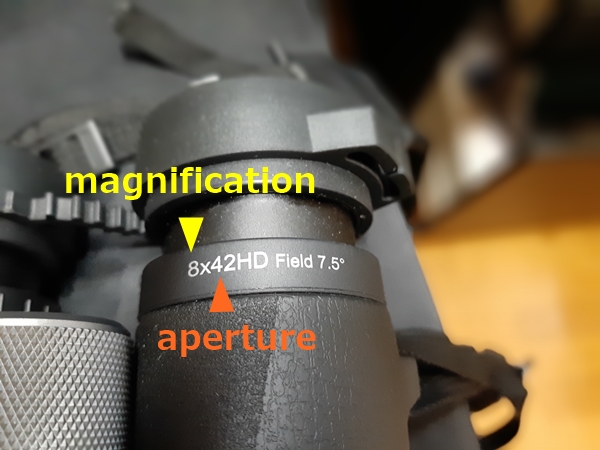With digital devices, it’s often true; the smaller, the better. Compactness is important, especially when you have to carry it around.
On the other hand, astronomers have been building continually larger and larger telescopes. In the late 1700s, a British astronomer, William Hershel, was successful in making the first giant reflecting telescope with a 122cm aperture. Since then, a lot of giant telescopes have been built.
How about binoculars? You can shop for different size pairs. Some are small enough to fit in your pocket, and others are so large that you need to mount them on a tripod.
In this post, I’ll explain what aperture is and why it’s important when choosing binoculars.
What do the two numbers on binoculars mean?
The aperture on binoculars is the width of the objective lenses. You don’t need a ruler to measure it because the number is usually stamped onto the pair (see below).

The first number is the magnification, and the second is the aperture.
However, the lens housing and baffles inside the barrels to get rid of stray light and internal reflections reduce the diameter.
The actual diameter of the objective lenses is called “effective aperture,” which you can check easily. Just shine a light through the eyepiece and measure the diameter of the circle of light (see below).

Usually, the effective aperture is a few millimeters smaller than the number on the specifications.
Why do we want large apertures particularly for astronomical use?
The larger the aperture, the more light it can collect: the volume of light increases in proportion to the area of the objective lenses.
You might assume that an aperture with twice the width would double the volume of light, which is not true. Let’s compare 5×20 with 8×40.
10×10×π=100π
20×20×π=400π
Thus, a 40mm objective lens can collect four times as much light as a 20mm lens.
In daylight, the difference is not as important because our pupils shrink to restrict the amount of bright light entering our eyes.
At night, however, the difference is important. Our pupils dilate to allow all of the light coming through the objective lenses.

The most important factor for stargazing is brightness. For example, with an 8×30 pair, which is often used for birdwatching, you won’t be able to see many stars, even on a pitch-black night. But, with 7×50, which is typical for stargazing, you‘ll be able to see a lot of dim stars with a slightly grayish background.

Giant binoculars for astronomy (aperture: 100mm).
I used to have a pair of 100mm binoculars for astronomical use. It was a lot of fun to see the Orion Nebula with that pair. I remember seeing a mixture of blue and pale pink that made the nebula look like a bird flying in the night sky.
Summary
The aperture on binoculars is the width of the objective lenses. The second number stamped on the binoculars show the aperture. The actual aperture or the effective aperture is slightly narrower.
How much light the binoculars can collect depends on the aperture. The volume of light increases in proportion to the area of the objective lenses.
Unlike compact digital devices, having a large pair of binoculars can be advantageous. Brightness is essential especially in stargazing because the stars and nebulae are very dim. This is why astronomers prefer giant binoculars with apertures of 100mm or more.
